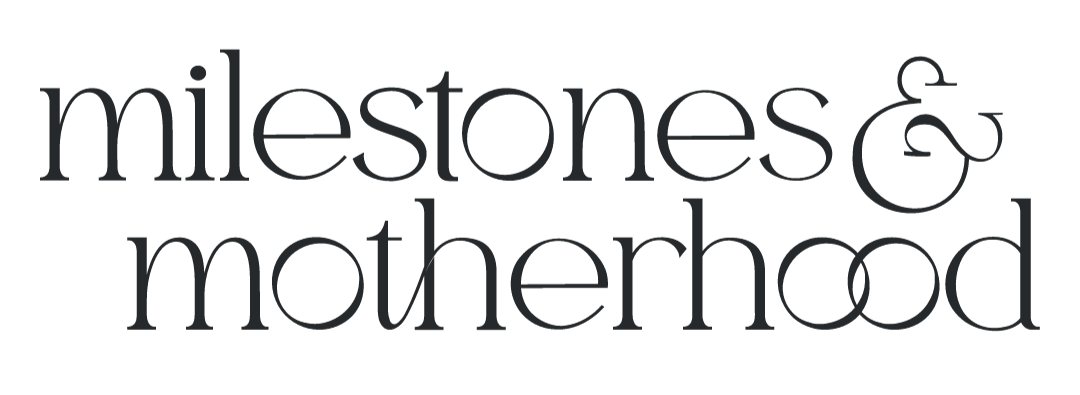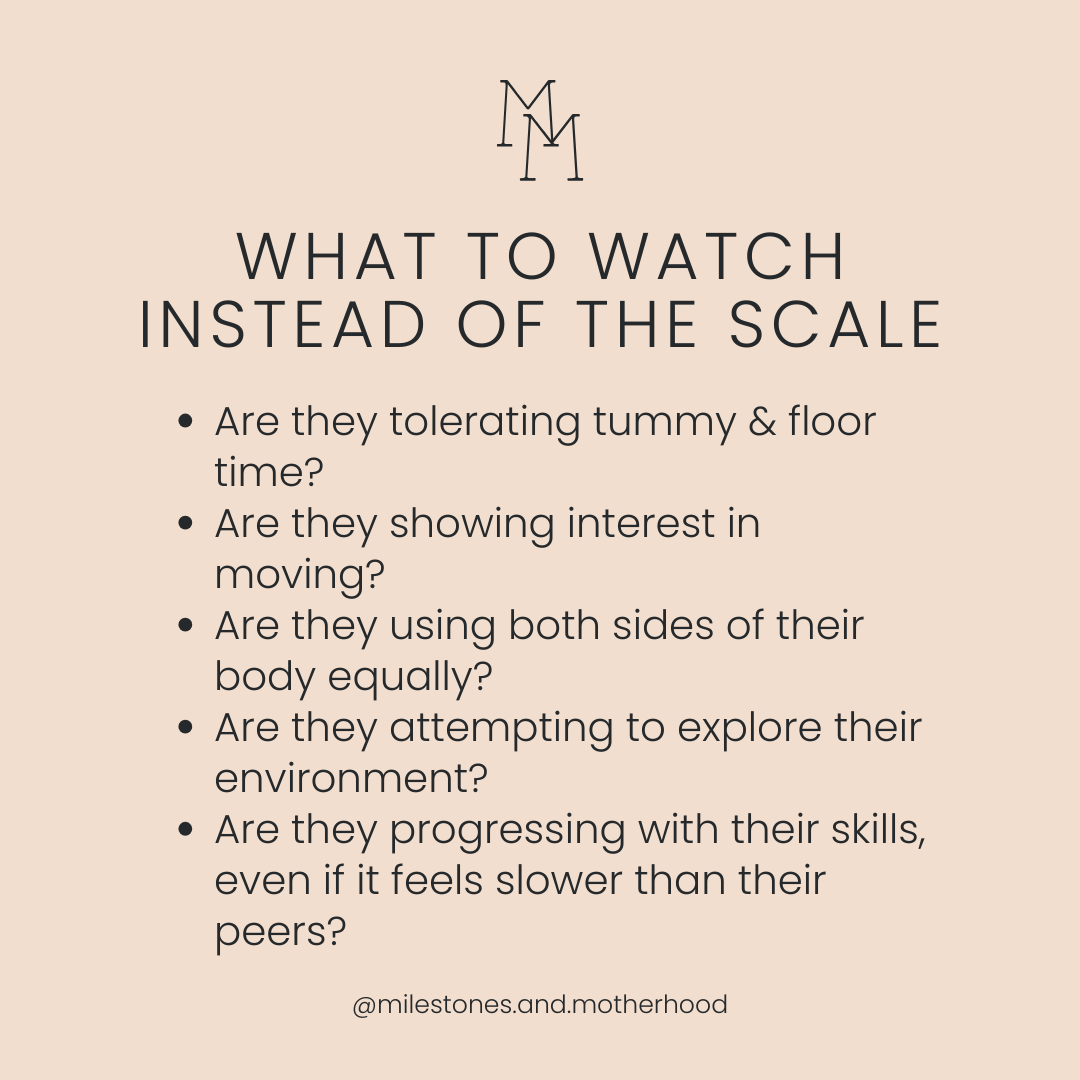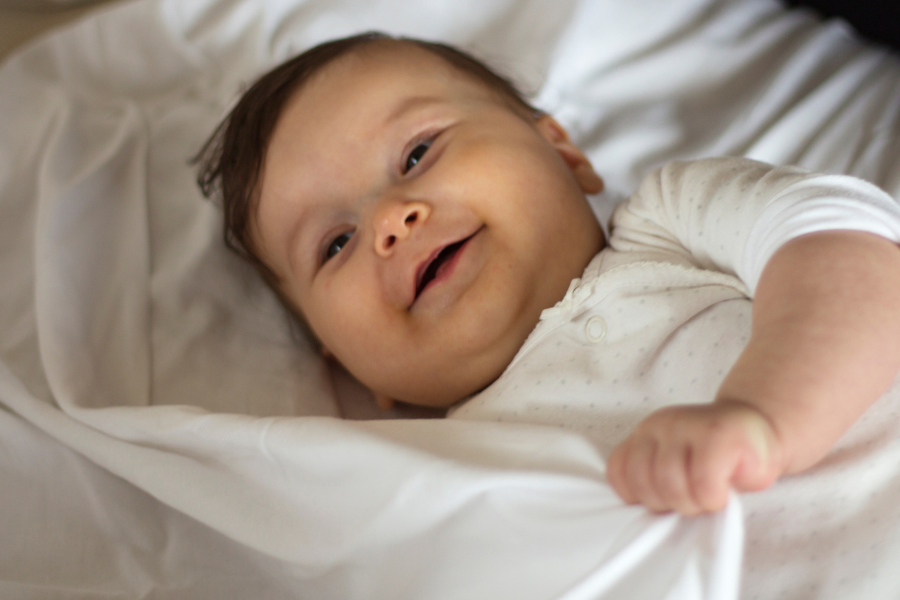Will My Big (Or Small) Baby Be Delayed? What You Should (and Shouldn’t) Worry About
Is My Baby Behind Because They’re Big (Or Small!)?!
If you’re wondering if your baby’s weight, height, head size, birth order, sex, etc can contribute to milestone acquisition (both delays OR meeting milestones on the ‘earlier’ side), you are NOT alone.
I think I speak for many of us parents when I say - I truly understand how triggering it can be to get stuck in the comparison rut when it comes to our babies- whether it be about their size, their milestone acquisition, or any of the other million things we can get in our heads about. But the truth is, while things like size CAN play a role in milestones, it’s rarely just about size, so let’s talk about what the research says, what you need to know, and what you can pay attention to instead.
Let’s Clear This Up: What the Research Does (And Doesn’t) Say
The truth? There is NO solid evidence available that supports size alone being indicative of when a baby will meet their milestones.
While some studies DO show a correlation between things like size and certain skills (like crawling), it is NOT causation - and factors like birth history, gestational age/prematurity, medical diagnoses & environment are crucial factors to consider as well.
More than anything before we dig in further, I want you to hear me when I say that milestone ranges & expected time frames for skills to emerge are wide for a reason - and size alone is never going to be the sole factor in when milestones like rolling, sitting, crawling & walking emerge.
Why Size Can Contribute But Isn’t the Root Cause
Before we move, it is worth noting that if your child is truly falling outside average ranges for milestones, there IS usually other reasons for that and it is ALWAYS worth bringing your concerns to your pediatrician.
Back to it!
The truth is, there are SO many factors that contribute to milestone acquisition - everything from personality (a big one in my opinion - more on that below!), environment, birth history, gestational age, etc. And while there is no conclusive research that suggests size is the PRIMARY cause of milestone delays, there ARE times when a baby’s size may be a contributing or compounding factor, so let’s talk about what that may look like!
Here are some times that size may be part of milestone acquisition or delays:
Higher body mass - Some babies who are heavier may struggle with lifting their head & upper body during tummy time and/or when working towards being on hands & knees & crawling.
Bigger babies may also fatigue faster than their peers and/or avoid movements they don’t feel confident in or that feel too effortful.
Some studies HAVE shown when a baby or child is classified as overweight or obese and/or as having high subcutaneous fat, there can be an association with delayed infant motor development (about 2x as likely when compared to non-overweight infants), however these studies often lack strong evidence and study methods.
Larger head size - Head size can make it a bit trickier to sustain holding their head up during things like tummy time or sitting, or even the development of head control.
Shorter limbs relative to body size - Differences here can contribute to a baby needing to adapt & develop different leverage & movement patterns, which may take a bit more time.
But the key point here: NONE of this causes delays - it just means they may need a little extra support to build strength, coordination & confidence!
If that’s your baby right now, check out my Mastering Rolling & Sitting course, designed to help any baby gain confidence in just 20 minutes a day, all through purposeful play.
Milestone Delays Almost Always Have More to Do With Multiple Factors Than Size
If you take one thing away from this blog, let it be this - Milestone delays almost ALWAYS have more to do with multiple factors than size alone.
A few of the biggest factors for milestones delays can include:
PERSONALITY
Honestly, in my experience, personality plays WAY more of a role in a child's milestones than height or weight! Some children on the heavier or taller side, or on the smaller/shorter side may be really motivated to move and figure it out in whatever way works for them, or may be more content to sit back & take a bit more time. I've absolutely seen it go both ways, but the reality is personality & motivation play a huge role in milestone acquisition.
BIRTH HISTORY & GESTATIONAL AGE
There is research that suggests babies born prematurely and/or that are diagnosed as Small for gestational age (SGA) may meet some milestones earlier on average (like independent sitting, for example) while some may be later on average (like rolling, for example) - however sample sizes are small and often retrospective in nature, relying on parent report.
MUSCLE TONE VARIATIONS
Both low & high muscle tone can be contributing factors to milestone acquisition, even when falling within what would still be considered ‘normal’ ranges.
ENVIRONMENT & OPPORTUNITIES FOR FLOOR TIME
One of the BIGGEST contributing factors to milestone acquisition is opportunity. Babies have to be given free floor time to move, explore & play in order to master both ministones (the smaller skills that lay the foundation for the bigger skill) AND milestones.
ORTHOPEDIC FACTORS
Things like torticollis, hip dysplasia, flattening on the skull, etc can all play a role in a baby's ability to move freely, explore & work towards skill mastery.
While there are SO many factors that can contribute to milestone acquisition, the most important thing to know is that if something feels off - it is ALWAYS okay (and important!) to bring it up with your pediatrician and/or discuss whether a PT referral is appropriate. And if you’re not sure what milestone to expect or when to expect them, be sure to check out my 0-3 Year Milestone Checklist!
What to Watch Instead of the Scale
While I hope the information above helps set your mind at ease regarding baby’s size & milestones, I know firsthand how helpful it can be to also know what TO focus on - so here’s a quick list of important things to consider:
Are they tolerating tummy & floor time?
Are they showing interest in moving?
Are they using both sides of their body equally?
Are they attempting to explore their environment?
Are they progressing with their skills, even if it feels slower than their peers? Considering ‘ministones’ can be SO helpful here, you can find tons more on what that means & what to watch for here.
Overall, know that development isn’t linear, and big (and small) babies can (and do!) hit milestones beautifully when given time and support.
Supporting Bigger & Smaller Babies Through Movement
If your baby does seem to be struggling with floor time, tummy time or milestone acquisition - here are some quick tips that often make a world of difference.
During tummy time if baby is struggling to lift their head or press through extended arms, try modifying by adding in a small towel roll or boppy under their chest. The goal is to have their arms resting on top of or in front of it to allow them to work on head lifting and pressing up against gravity in a smaller range of motion.
Encourage them to play in multiple positions while on the floor. This can include playing on their backs, in sidelying on the right and left, on their bellies, and even in semi-reclined supported sitting positions (think reclined against your legs). Providing a variation of play positions is HUGE for development, encouraging milestones like bringing hands to midline & head control, reducing pressure on the skull that contribute to flat spot development & more.
Consider environment set up and their play space. If baby is tending to stay in one spot & only engage with what’s within arms reach, explore placing things slightly out of their reach to encourage movement. Added bonus - placing toys on diagonals rather than directly in front of them not only encourages movement, but also begins laying the foundation for postural control & trunk strengthening that will carry over into everything from rolling to crawling, walking & beyond!
And if you’re like me and want milestones to be simple & easy because you simply cannot add one more thing to your plate, I’ve got you covered in my Rolling & Sitting Class!
When to Ask for Extra Support & Shifting The Focus From Size
When it comes to asking for extra support, remember you don’t need to panic, but you can be proactive.
Size truly does NOT define your baby’s potential, but if you have ANY concerns about your little one's milestones, regardless of size, know that you deserve to be heard and your concerns validated & assessed further.
And more than anything, know that you’re doing the right thing by paying attention and asking questions. If your baby isn’t moving quite like others, that’s not a reflection of you OR of them - it’s just a sign to lean in with support for where they currently are AND where you know they’re headed!
Looking for More Developmental Support?
The Complete Roadmap to Support Rolling + Sitting: So you can confidently help your baby hit these key milestones without the stress, second-guessing, or “is this normal?” Googling.
This masterclass walks you through exactly what to look for, what to encourage, and how to confidently support your baby’s rolling + sitting journey & as always…ALL THE SUPPORT YOU NEED!!









